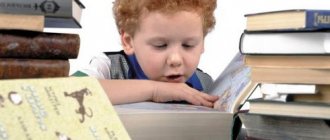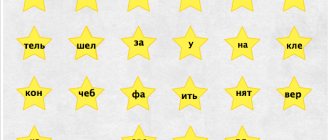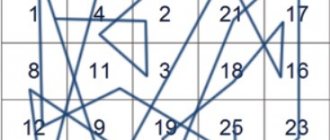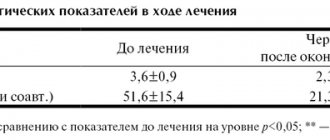Has your child already learned to add syllables, but does it very slowly and with errors? How to overcome these difficulties and help a child learn to read in words and understand what they read well?
Firstly, there is no need to force him to read long texts until he is completely exhausted. This will be mechanical work, which, if it produces results, will be very insignificant.
Secondly, the child needs to create a situation of success. It is imperative to praise him, even for a small achievement.
And thirdly, the child should not overcome enormous resistance within himself. Therefore, you need to use small simple texts, and it is best to start working with syllable tables.
What are syllable tables and how to work with them
The syllabic chart for preschoolers consists of columns of vowels and rows of consonants, and when they intersect, syllables are created. It is initially easier for children to learn vowel letters, since the sound stretches out and can be sung.
Training is based on acquiring the skill of combining a vowel and a consonant sound in order. For example, having chosen the letter M, the child will have to form the syllables MA, ME, MU, MO, MI, WE. The syllable table is ideal for this. Thus, the child masters a new letter and learns to create syllables.
Tables can be black and white, but most often they are colored, consonants are blue, vowels are red. Some cells will be empty, since the combination is impossible, for example, words with the syllables GY or JY are not used.
Reception "Tug"
The “Tug” technique is used to increase the pace of reading. The leader can be a teacher or a student with a high reading technique. He reads the text, and the rest should try to keep up with him. This exercise can be done for the whole class or in pairs.
To control the reading process of all students, you can make sudden stops and ask the children to show the last word read in the text. Another way is to make mistakes while reading. Those who read “in tow” should notice them and correct them.
From what age can it be used?
Teachers recommend starting to read no earlier than 5 years of age.
The effectiveness of learning largely depends on the child’s development; at the time of learning, he must have the following skills:
- pronounce all letters;
- be able to retell a short story;
Before starting education, you should determine the child’s readiness for reading and school in general.
- have developed auditory memory, in accordance with age, for example, at 4 years old a child should remember 4 words, at 5 years old - 5 words;
- the child remembers simple quatrains.
In general, everything is individual; tables are classified as tools of visual perception. Such material is not always used in schools, so it is better to use the technique in preschool age to avoid confusion.
Course program
The course consists of 2 parts:
Organizational part – algorithms and tools for building the educational process
- • Setting educational goals and monitoring their achievement
- • Construction of educational routes
- • Motivating the child to achieve their goals
- • Time management of the learning process (from lesson structure to the entire school education)
- Methods for express assessment of knowledge and skills
- • Algorithms for consolidating results (long-term memorization and restoration of knowledge)
- • Ways to develop memory, attention, logic and other learning skills
The technological part – algorithms and tools for learning, memorizing and working with information.
- • Technologies for developing skills and mastering foreign languages
- • Mnemonics (techniques for memorizing texts, numbers, foreign words, terms and data structures)
- • Non-linear note-taking (drawing and 100% memorization of Mind maps)
- • Algorithms for working with text (highlighting the main points, structuring and remembering information)
- • Multi-level training (algorithm for independent mastery of any subject area)
- • Algorithms for preparing for oral exams and tests (USE/OGE, etc.)
- • Memorizing definitions, theorems, formulas, classifications, etc.
- • Algorithms for searching and analyzing information (selection of books/textbooks, Internet search)
- • Technology for memorizing the spelling of foreign words and vocabulary words of the Russian language
- • Algorithms for writing articles, abstracts, reports, research papers and diplomas
- • Techniques for 100% preservation and rapid restoration of previously studied material
submit your application
Types of exercises with syllable tables
Nowadays everyone has a computer, so printing out the table and cards is not particularly difficult. As a last resort, you can draw the manual manually. The study must be carried out in stages, more clearly in the table below.
| Type of exercise | Example | Methodology |
| Learning simple open syllables | BA, KU, MI, TO | One column needs to be read for several days until the material is completely consolidated. You can read both left-to-right and right-to-left. |
| Studying closed syllables | MOL, OX, POL | You need to create several similar tables, with different consonants, and change them periodically. |
| Learning words with a combination of vowels and consonants, consisting of 4 letters | DARKNESS, SLAN, MARRIAGE, TABLE | The child trains to connect different combinations of letters; non-existent combinations can be used. |
| Learning difficult to read letter combinations | ARKAN, BROMC, VROX, TRIBS | The child consolidates the skill of speed reading. |
| Studying syllables with b, b, j | EAT, LYA, IODINE | The skill of sound pronunciation for difficult letter combinations is strengthened. |
It’s difficult for kids to immediately get involved in their studies and learn the concepts of open and closed syllables. To begin with, you can consolidate the skill in a game form.
There are these types of games:
- Word breakdown. For this, both a syllabic table and cards are used. For example, the word needs to be composed of the word KO-RA, the child must find these syllables.
- Consolidating the skill of learning a syllable. For example, on the letter K, the child needs to come up with a word with the combination KA, KO - CAT, COW.
- Auditory memory training. For learning, cards are already needed, the adult makes up a word in front of the child and adds an extra syllable, for example - MA-SO-SHA, the preschooler must determine where the mistake is.
If a child finds it difficult to name a letter, you can help, but you should not name it separately, but read the entire syllable. This way there will be no pauses while reading.
Techniques for expanding your angle of vision
In the process of reading, the number of characters that fall into the child’s field of vision matters. To expand the angle of peripheral vision, it is recommended to offer children the following exercises.
Schulte tables
Schulte tables contain numbers from 1 to 30, which are arranged in a chaotic order. Students need to find and indicate each number in order in 30 seconds. After a few days, you should offer another version of the table.
- See Schulte Table Generator Online.
Find the word
The essence of this exercise is similar to the previous one. On a piece of paper you need to write several different, not very long words in random order. The task for schoolchildren is to find words on a sheet of paper as quickly as possible, which the teacher will name one by one.
Word pyramids
For such exercises, words are written in a column, starting with the word with the fewest letters. Each word is divided into two parts, which are written at some distance from each other. On each subsequent line this distance increases.
First - last
You can use any text for this exercise. Children only need to read the first and last syllable of each line.
Reading frame
It is necessary to prepare a strip of cardboard with a slot, the height of which is slightly greater than the height of the letters in the textbook. The width should be small, about 3 - 4 letters. While reading, the child moves this frame around the text. After a certain time, the width of the frame should be gradually increased.
Over time, children remember many words that appear frequently in texts and perceive them as a whole. They no longer read such words, but name them right away. This skill significantly saves time when reading, so this skill needs to be purposefully developed.
Types of syllabic tables
Syllable charts serve as learning tools for preschoolers and help children become accustomed to the visual perception of letters and open syllables. The formation of reading skills is carried out from simple to more complex, therefore there are separate manuals for preschoolers and primary school students.
For preschoolers
This is the simplest type of tables, which reinforces the skill of forming simple syllables, while simultaneously learning letters. At this stage, the child learns to connect letters - at the intersection of horizontal and vertical. Understanding the sound-letter structure helps to perceive and read syllables as a whole.
Syllable table for preschoolers
Next, the child learns to quickly connect letters, then he can find the syllables that an adult reads. Preschoolers spend a lot of energy reading and reproducing two letters, so learning complex words at this stage is not advisable. The syllables are selected as simple as possible - KA-SHA, VO-DA.
For primary school students
At school, children are also taught letters, but the number of hours is limited and this may not be enough for the child. Initially, children are shown simple syllable tables. In order to consolidate the skill, tasks are immediately proposed, for example, for each syllable you need to come up with a word.
Schoolchildren are taught to use letters both at the beginning and at the end of words.
Syllable table for elementary school students
Syllable table for elementary school students
Syllable table for elementary school students
Syllable table for elementary school students
Syllable table for elementary school students
Then, they move on to studying closed syllables; there are also specialized tables for this. Combinations of letters with soft and hard signs cause difficulties. It is even more difficult to master the transitions from short to long syllables, so it is recommended to use the Zhukova and Zaitsev technique.
How to make a child want to read?
For a child who still reads syllables, the process of reading is a lot of work. At this moment it is very important not to force, but to interest the baby!
Especially for this period, I wrote small but interesting educational texts. All words are divided into syllables. Each test has questions that help you understand how much your child understands what they read. Complete answers to the questions asked will contribute to the child’s speech development.
The book contains 20 stories. Each of them is complemented by a coloring picture, which also arouses the child’s interest.
Download the book COLORING TRAINER “Reading by syllables”
Syllable tables according to Zhukova’s method
A syllabic table for preschoolers, developed according to Zhukova’s ABC book, involves a step-by-step learning of the alphabet. The technique involves combining a sound approach with a speech therapy approach. Reading is carried out not with a single letter, but with a syllable. The same principle is pursued in N.S.’s primer. Zhukova.
The algorithm is as follows:
- The child learns several letters at once and puts them into syllables. Initially, vowels are studied - A, O, U. Learning to merge sounds is as follows - the first letter is drawn out, the second is played briefly. In Zhukova’s primer there is even a visual image where, between the syllable AU, a path is drawn along which a person moves.
Syllable table for preschoolers, developed according to Zhukova’s ABC book
Syllable table for preschoolers, developed according to Zhukova’s ABC book
Syllable table for preschoolers, developed according to Zhukova’s ABC book
Syllable table for preschoolers, developed according to Zhukova’s ABC book
Syllable table for preschoolers, developed according to Zhukova’s ABC book
Syllable table for preschoolers, developed according to Zhukova’s ABC book
Syllable table for preschoolers, developed according to Zhukova’s ABC book
- After fixing the vowels A, U, O, a syllabic table is used, with the consonants M, S, X, R, Sh. The child will try to read different variations of syllables - MA, OM, HA, UH, SHA, USH, RO, AR.
- Then the vowel letter Y and the consonants L, N, K, T are added to the table. The child learns to combine the vowel Y and previously learned consonants.
- Next, they study the letter I, in the table it is combined with the consonants - M, S, X, R, Sh, L, N, K, T.
- The syllabic table for preschoolers is also focused on learning the consonants P, Z, Y, G, V, D, B, Zh, they are combined with the vowels A, U, O, Y, I.
- Afterwards, the child is asked to learn the letters E, E, I, Yu, E. The table has a standard format: horizontally - four vowels, vertically - the studied consonants: M, S, X, R, Sh, L, N, K, T , P, Z, G, V, D, B.
- The consonants Ch, Ts, F, Shch are also highlighted in a separate table; they are combined with the vowels: A, U, O, Y, I, E, Yo, Yu, Ya. In this case, cells with incorrect combinations of sounds FYA, CHYU will be empty , CI.
- The final table combines all syllables with letters of the alphabet.
There are separate manuals, according to Zhukova’s ABC book, that involve connecting syllables of 3 or more letters. The principle is also based on the combination of syllables with vowels A, O, U; for example: SMA, SMO, SMU. Then there are tables with the letters I, Y (SMY, SLI). In this sequence, you can study any syllables, then you can start reading words.
"Hidden Letters" Technique
Improving reading technique is facilitated by developing the ability to predict words rather than read them letter by letter. To do this, you can offer the following tasks:
- words with blots - a word is written on the card, part of which is covered by a blot;
- words with missing letters - there is a word on the card in which several letters are missing;
- cut word - a card with a written word is cut lengthwise and children are asked to read the word either along the upper or lower part (the word can not be cut into pieces, but cover half of it with a ruler);
- A more difficult version of this exercise is to predict the missing word. For it, you can use catchphrases, phraseological units, famous phrases from fairy tales or poems, riddles with rhyming answers.
Zaitsev's syllabic tables
Zaitsev's method is based on reading by warehouses. The material is provided in the form of a set of cubes of different sizes, on which various letters and syllables are printed; the kit also includes 4 tables, they have a fairly large font.
It is believed that this technique is suitable even for the smallest children, since children have a visual aid. The cubes have special fillers, which makes it easier for a child to understand where a hard, soft or ringing sound is. Syllables are written in different colors.
Zaitsev's syllabic tables
Zaitsev's syllabic tables
A preschooler forms an image of a warehouse based on sensations, without separating letters from words. Logical thinking is also formed by visually consolidating information in tabular form. Classes are conducted in a playful way, but at the same time, fluent reading skills are reinforced.
However, schoolchildren who were taught using this method experience difficulties in tasks where it is necessary to highlight syllables, since the warehouses do not coincide with them. For example, in the word HANDLE, there are 2 syllables - RU-CHKA, but it consists of 3 warehouses - RU-CH-KA.
Texts for training reading technique: ready-made options
Training reading techniques is possible using any text, but you can use small, ready-made options. We offer you several suitable texts for practicing your reading technique.
Text 1
Text 2
Text 3
Text 4
Text 5
How to speed up the process of improving reading skills
Syllable tables for preschool children have different variations - from simple to complex. It is important to monitor how the material is being absorbed and to avoid gaps in knowledge; it may take twice as long to learn a single letter or syllable, but the skill needs to be consolidated.
You need to work not only with tables, you can select short phrases and stories so that the child understands that words form a text that makes sense. It is better to place the aids in the child’s work area so that in case of difficulties there is always a hint.
Syllable tables intended for preschoolers can be studied using any method convenient for the child. Teachers often combine several methods and choose easier-to-understand options. In addition to the main table, it is recommended to use auxiliary aids in the form of cards or cubes.
Technique "Lightning"
The use of the Lightning technique is as follows. Children are shown a word for a very short time, and they must have time to read it. For this exercise, you can prepare flashcards or create a presentation in which words appear and disappear after a couple of seconds.
The same set of words should be used for several days in a row until the students remember them all. Then offer another selection of words. For a better effect, you can not just let schoolchildren read the word, but also ask them to write it after it disappears.








